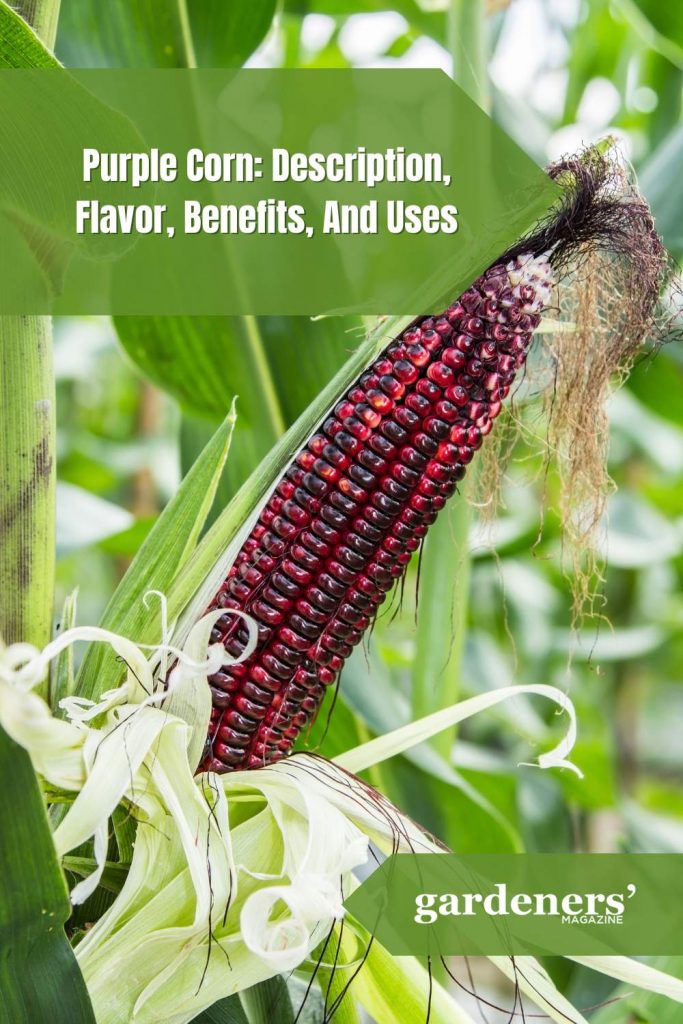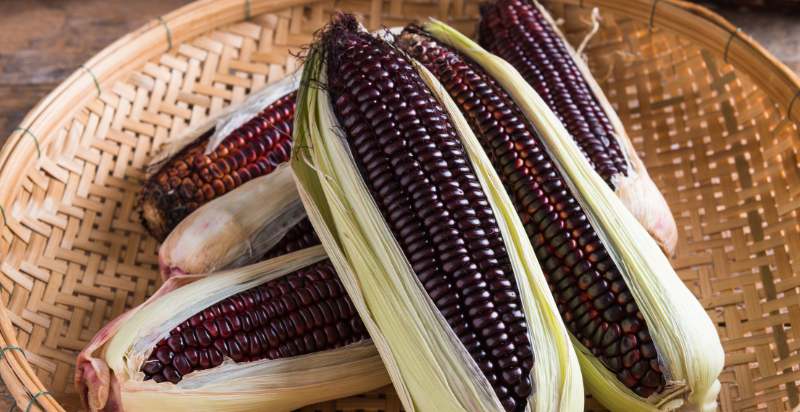Purple corn is a type of corn that has been cultivated for thousands of years. It is native to the Andes region in South America and was an important crop for the Inca Empire. The kernels are either deep purple or blue-black with a soft texture, and they are used to make various dishes such as tortillas, tamales, soups, pudding, and more. Purple corn has high levels of antioxidants and potential cancer-fighting properties. This article will discuss its history, uses, nutritional value, health benefits, and ways to incorporate it into your diet.
What is Purple Corn?
Purple corn is a type of corn that comes from Peru and has been grown for many centuries. It has a rich purple color and is packed with beneficial antioxidants, minerals, and vitamins such as C, B6, A, K1, carotenoids, and polyphenols. These nutrients make it a highly nutritious food that can help support good health.

History and Origin of Purple Corn:
A unique variety of purple corn has been grown for a very long time in the Andean region of South America, spanning from Peru to Bolivia and Argentina. These corns are also found in the cool mountain regions of Mexico. The Incas, who were known to employ this ancient strain in their religious rituals and as a food source, are believed to have cultivated it first. The Incas highly valued purple maize for its distinctive flavor, texture, and hue. It has been a staple of South American cuisine for many years and is still used in many traditional dishes.
The purple color of corn comes from a type of antioxidant pigment called anthocyanin, which is found in many other foods, such as blueberries, grapes, and cherries. Purple corn has several nutritional benefits, including helping to reduce cholesterol, improve circulation, protect against cancer, and lower blood sugar levels.
Growing Conditions of Purple Corn:
Purple corn is a resilient crop that can be grown in various climates, although it thrives best in warm and sunny conditions. It needs at least six hours of direct sunlight per day and prefers temperatures between 71-77°F (22-25°C). The soil should be well-draining, moist, and slightly acidic to ensure optimal growth. Purple corn is a drought-tolerant crop that can survive up to four weeks without water.
Seasonality and Availability of Purple Corn:
Purple corn grows best in the southern and southwestern regions of the U.S. (USDA zones 9-11) with a long, warm growing season. Plant it in early spring and harvest in late summer to early fall. Some areas may allow for a second planting in late summer with a late fall harvest. In zones 6-8, the growing season is shorter and planting occurs after the frost danger has passed. Harvest is in late summer. These areas can still grow purple corn by using techniques like mulching and row covers to extend warmth and selecting suitable varieties with shorter growth periods.
In the cooler regions of zones 3-5, growing purple corn can be difficult due to shorter growing seasons and lower temperatures. Gardeners and farmers in these areas often use greenhouses or start seeds indoors to protect plants from the cold and extend the growing season. However, with careful planning and selection of suitable varieties, it is still possible to grow purple corn in these regions, although the planting and harvesting window is typically narrower, from late spring to early fall.
Health Benefits of Purple Corn:
Peruvian corn is a great source of antioxidants that can protect cells from damage and prevent various diseases. It is also rich in dietary fiber, vitamins, minerals, and phytonutrients. Purple corn, in particular, contains anthocyanins that give it its bright color and offer several health benefits, such as reducing cholesterol levels, improving blood circulation, guarding against cancer, and lowering blood sugar levels. Furthermore, purple corn contains zeaxanthin and lutein, which are powerful antioxidants that can protect the eyes by filtering out blue light that can harm them.
As far as I know, the purple corn has no significant side effects and is safe to eat. But as always, a doctor or a medical professional is the right person to advise you on the health benefits.
Can Dogs Eat Purple Corn?
Yes, dogs can indeed eat cooked purple corn with no added ingredients. However, it is important to be aware of any potential corn allergies your dog may have prior to feeding. I always recommend that you consult your vet before introducing a new type of food or any food that you are unsure about.
Where are Purple Corn Grown and Harvested?
Purple corn is typically grown in the Andean region of Peru, Bolivia, Ecuador, and other parts of South America. The plant is found at higher altitudes, usually between 4500-6500 feet. It’s also grown in some parts of Europe, such as Italy and Austria.
You can sow the purple corn seeds directly into the soil. These corns are an early-maturing corn variety, and you will have the harvest ready within 60 to 62 days after planting.
The harvesting season for purple corn typically falls between July and October, depending on the climate of the region. The cobs are harvested at the point when they turn a deep purple color and become dry. It is important to harvest the corn at the right time to ensure that it retains maximum nutritional value. After harvesting, the kernels can be dried or boiled and used for various traditional foods and beverages.
What is the Flavor Profile of Purple Corn?
Purple corn has a sweet and unique flavor that can best be described as a cross between blueberry, raspberry, and honey. It also carries subtle notes of vanilla and freshly cut grass. Depending on the variety of purple corn used, some may have nuttier or spicier undertones. The sweetness intensifies when cooked or boiled, making it the perfect addition to various dishes.
Where can the Best Quality Purple Corn be found?
The best quality purple corn can be found at local farmers’ markets, specialty health stores, and online retailers. When purchasing online, make sure to do your research and look for brands that specialize in organic, non-GMO ingredients. Additionally, check the product label for the country of origin—it should be South America, where most of the world’s purple corn is produced.

How do you store Purple Corn?
To keep purple corn fresh, it should be stored away from sunlight and kept in an airtight container. When stored at room temperature or in the refrigerator, it can last up to three months. If you want to keep it fresh for a longer time, you can freeze it for up to six months. For best results, it is recommended to defrost it gradually in the refrigerator before use.
What are some uses for Purple Corn?
Purple corn can be used in a range of dishes. One of the most popular ways to incorporate purple corn is by making chicha morada, a sweet and tart drink made with boiled and sweetened purple corn, pineapple, cinnamon, cloves and sometimes other fruits such as apples or oranges. It’s delicious served cold on hot days! Another tasty use for purple corn is in a salad. Try combining cooked purple corn with diced tomatoes, chopped red onion, and cilantro.
Drizzle the salad with a light vinaigrette or lime juice for extra flavor. Another great way to enjoy this unique vegetable is to make spicy tacos topped with grilled shrimp or fish. Simply mix cooked purple corn with diced green bell peppers, cilantro, and a touch of chili powder. Serve with your favorite taco toppings for a zesty meal.
The popular purple corn tea is a healthy drink made from purple corn and consumed in the late autumn and winter evenings in most Korean households. This tea is typically made using a blend of roasted corn and purple maize cob, with about 77% roasted corn and 17% purple maize cob.
Purple corn is also perfect for adding to smoothies or oatmeal bowls – it adds a unique sweetness that can’t be beaten! And lastly, why not try making some purple cornbread? Just mix cooked purple corn with baking staples like flour, eggs, and sugar, and bake until golden brown – yum! There are so many delicious ways to enjoy this vibrant vegetable. Try it today!
There are various types of corn available in the market including green, yellow, black, and rainbow corn. However, their differences in taste are only subtle.
Conclusion:
Purple corn is a versatile and nutrient-rich ingredient that can be used in many ways. From making tortillas to baking bread, this rich grain can be enjoyed in a variety of dishes. If you want to store purple corn for later use, freeze it for up to six months. With its mild flavor and vibrant color, adding purple corn to your meals will elevate them to the next level.
- Fuerte Avocado: History, Flavor, Calories, Benefits, And Uses - March 27, 2024
- Everything You Wanted to Know About Barhi Dates - March 23, 2024
- Everything You Wanted To Know About Beech Mushrooms - March 23, 2024
